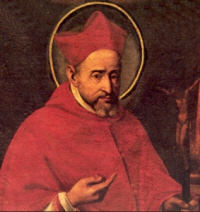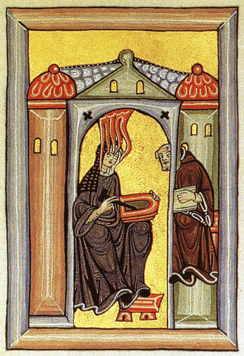Ordinary Time: September 17th
Optional Memorial of St. Robert Bellarmine, bishop and doctor
Old Calendar: Impression of the Stigmata of St. Francis; St. Hildegarde. abbess (Hist)
St. Robert Bellarmine (1542-1621) was born in Montepulciano, Italy, and died in Rome. The son of noble parents, he entered the Society of Jesus, finishing his theological studies at Louvain, Belgium. His services to the Church were outstanding and many. He occupied the chair of controversial theology in Rome. He defended the Holy See against anti-clericals. He wrote books against the prevailing heresies of the day. His catechism, translated into many languages, spread the knowledge of Christian doctrine to all parts of the world. He was the Counsellor of Popes and spiritual director of St. Aloysius Gonzaga. He helped St. Francis de Sales obtain approval of the Visitation Order. As a religious he was a model of purity, humility and obedience; as a bishop and Cardinal, an example of great love for his flock.
According to the 1962 Missal of St. John XXIII the Extraordinary Form of the Roman Rite, today is the feast of the Commemoratioin of the Imprinting of the Holy Stigmata on the Body of St. Francis and St. Robert Bellarmine's feast is celebrated on May 13. Two years before his death St. Francis retired to Mt. Alverno where he began a forty days' fast in honor of St. Michael the Archangel. There, while in a state of continual prayer and unceasing watching, he saw in a vision a seraph with burning, dazzling wings whose feet and hands were nailed to a cross; at the same time five wounds, like those of our Lord, appeared on Francis' feet, hands and side; from the wound in his side blood flowed. These stigmata were so fully verified subsequently that the Franciscans since the fourteenth century have celebrated a feast in honor of the event.
St. Robert Bellarmine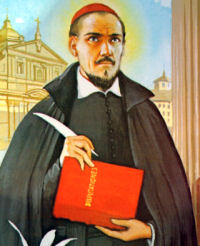 He was born at Montepulciano in Tuscany on October 4, 1542, the feast of the Poverello of Assisi toward whom he always cherished a special devotion. The day on which he died, September 17, is now the feast in honor of the stigmata of St. Francis.
He was born at Montepulciano in Tuscany on October 4, 1542, the feast of the Poverello of Assisi toward whom he always cherished a special devotion. The day on which he died, September 17, is now the feast in honor of the stigmata of St. Francis.
In 1560 Robert Bellarmine entered the Society of Jesus. He easily ranks among its greatest men, illustrious for learning as well as for piety, humility, and simplicity of heart. If it were possible to summarize his life in a single sentence, one that would resolve all the varied activities and accomplishments of his long career, a verse from the psalm might serve: "If I forget you, Jerusalem, may my right hand be forgotten." His most important work was controversial in nature but the impact of his presentation "resembled the final chord in a mighty cantata, a chord that resounded through all the vice and scandal resulting from the internal corruption of the Church of that day, and that chord heralded Mother Church as one, holy, and Catholic" (E. Birminghaus).
Bellarmine also acted as confessor to the youthful Aloysius and John Berchmans. It might be asked why three hundred years passed before the beatification and canonization of Bellarmine. Long ago Bishop Hefele pointed to the reason when he wrote: "Bellarmine deserves the highest degree of respect from Catholics, even though he has not been canonized. Those who labored to besmirch him have only erected a monument of shame for themselves!" Finally in 1923, he was beatified; canonization followed in 1930, and on September 17, 1931, Pope Pius XI declared him a doctor of the Church.
Excerpted from The Church's Year of Grace, Pius Parsch
Patron: canon lawyers; canonists; catechists; catechumens; archdiocese of Cincinnati, Ohio.
Symbols: red hat of cardinal; book denoting doctor of the Church; pictured in the red garments of a Cardinal.
Things to Do:
- Study the connections between Robert Bellarmine, Aloysius Gonzaga, and Francis de Sales.
- Learn more about the different translations of the Bible and what the Church approves.
- Learn more about the Code of Canon Law and what canon lawyers do, compared to regular lawyers.
- Read the Congregation for the Doctrine of the Faith's document, Doctrinal Note on Some Questions Regarding the Participation of Catholics in Political Life.
- Read The Seven Words on the Cross and The Art of Dying Well by St. Robert Bellarmine online.
Stigmata of St. Francis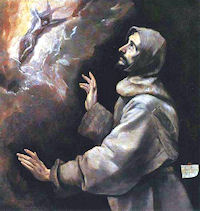 Saint Bonaventure, biographer of Saint Francis of Assisi, wrote that two years before his holy death he had been praying on Mount Alverno in a solitary retreat, where he had gone to fast for forty days in honor of the Archangel Michael. No one ever meditated more than Francis on the Passion of his Lord. During his retreat he beheld in vision a six-winged Seraph attached to a cross, and received at the same time a painful wound of the heart, which seemed to transpierce it. When the vision ended his own hands and feet bore the marks of the angelic crucifixion which he had seen in the vision. He understood by his vision that the soul must come to resemble Christ by the ardors of its interior fire, rather than by any physical, exterior means. We reproduce here a meditation of the saintly 19th century Abbot, Dom Guéranger of Solemnes in France
Saint Bonaventure, biographer of Saint Francis of Assisi, wrote that two years before his holy death he had been praying on Mount Alverno in a solitary retreat, where he had gone to fast for forty days in honor of the Archangel Michael. No one ever meditated more than Francis on the Passion of his Lord. During his retreat he beheld in vision a six-winged Seraph attached to a cross, and received at the same time a painful wound of the heart, which seemed to transpierce it. When the vision ended his own hands and feet bore the marks of the angelic crucifixion which he had seen in the vision. He understood by his vision that the soul must come to resemble Christ by the ardors of its interior fire, rather than by any physical, exterior means. We reproduce here a meditation of the saintly 19th century Abbot, Dom Guéranger of Solemnes in France
The Feast of the Stigmata of Saint Francis, whom we will soon honor again on his feast of October 4th, is not only to glorify a Saint; it commemorates and signifies something which goes beyond the life of any single man, even one of the greatest of the Church. The God-Man never ceases to live on in His Church, and the reproduction of His own mysteries in this Spouse whom He wants to be similar to Himself, is the explanation of history.
In the thirteenth century it seemed that charity, whose divine precept many no longer heeded, concentrated in a few souls the fires which had once sufficed to inflame multitudes. Sanctity shone as brilliantly as ever, but the hour for the cooling of the brazier had struck for the peoples. The Church itself says so today in its liturgy, at the Collect: ‘Lord Jesus Christ, when the world was growing cold, You reproduced the sacred marks of Your passion in the body of the most blessed Francis, in order that Your love might also set our hearts afire.’ The Spouse of Christ had already begun to experience the long series of social defections among the nations, with their denials, treasons, derision, slaps, spittings in the very praetorium, all of which conclude in the legalized separation of society from its Author. The era of the Passion is advanced; the exaltation of the Holy Cross, which for centuries was triumphant in the eyes of the nations, acquires in the sight of heaven, as the Angels look down upon it, the aspect of an ever closer resemblance with the Spouse to the sufferings of her crucified Beloved.
Saint Francis, loved today by all who know of him — and few there are who do not — was like precious marble placed before an expert sculptor. The Holy Spirit chose the flesh of the seraph of Assisi to express His divine thought, thus manifesting to the world the very specific direction He intends to give to souls thereafter. This stigmatization offers a first example, a complete image, of the new labor the divine Spirit is meditating — total union, on the very Cross of Christ itself, of the mystical Body with the divine Head. Francis is the one honored by this primacy of choice; but after him the sacred sign will be received by others, who also personify the Church. From this time on, the Stigmata of the Lord Jesus will be at all times visible, here and there on this earth.
—Excerpted from L’Année liturgique, by Dom Prosper Guéranger (Mame et Fils: Tours, 1919), “The Time after Pentecost V”, Vol. 14, translation O.D.M.
Things to Do:
- Read this story about St. Francis and the Stigmata.
St. Hildegarde 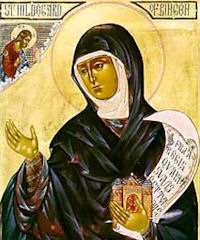 Called the "Sibyl of the Rhine," Hildegard of Bingen became the most famous mystic and prophet of her time. Her writings and music are still found in all major bookstores, and no woman saint is more popular in her native Germany. When she was eight, she was placed in a convent, where she later became abbess. She was a biblical exegete, visionary, preacher, composer, and herbalist, who corresponded with the major royalty and church leaders of her day, including four popes. Her greatest vision came when she was forty-two, which is recorded in her famous Scrivias, or Know the Ways of the Lord, a treatise whose magnificence rivals William Blake's visionary work. Hildegard's spiritual writings found approval during her lifetime, and her lectures on the spiritual life drew crowds from all over Europe. She wrote prolifically, on topics as varied as history and drama, polictics and and liturgical poetry. Her monastery joyfully sang the praises she wrote. During the last year of her life, when she was eighty-one, she entered into a conflict with ecclesiastical authorities because she allowed a young man who had been excommunicated to be buried in her abbey cemetery, and her convent was placed under interdict. It is probably that, for this reason, Hildegard was never formally canonized, although she is found in all major saints' books and her cult was approved locally because of so many miracles reported at her tomb.
Called the "Sibyl of the Rhine," Hildegard of Bingen became the most famous mystic and prophet of her time. Her writings and music are still found in all major bookstores, and no woman saint is more popular in her native Germany. When she was eight, she was placed in a convent, where she later became abbess. She was a biblical exegete, visionary, preacher, composer, and herbalist, who corresponded with the major royalty and church leaders of her day, including four popes. Her greatest vision came when she was forty-two, which is recorded in her famous Scrivias, or Know the Ways of the Lord, a treatise whose magnificence rivals William Blake's visionary work. Hildegard's spiritual writings found approval during her lifetime, and her lectures on the spiritual life drew crowds from all over Europe. She wrote prolifically, on topics as varied as history and drama, polictics and and liturgical poetry. Her monastery joyfully sang the praises she wrote. During the last year of her life, when she was eighty-one, she entered into a conflict with ecclesiastical authorities because she allowed a young man who had been excommunicated to be buried in her abbey cemetery, and her convent was placed under interdict. It is probably that, for this reason, Hildegard was never formally canonized, although she is found in all major saints' books and her cult was approved locally because of so many miracles reported at her tomb.
— Excerpted from Women Saints, Madonna Sophia Compton
Things to Do:
- Learn more about St. Hildegarde.
